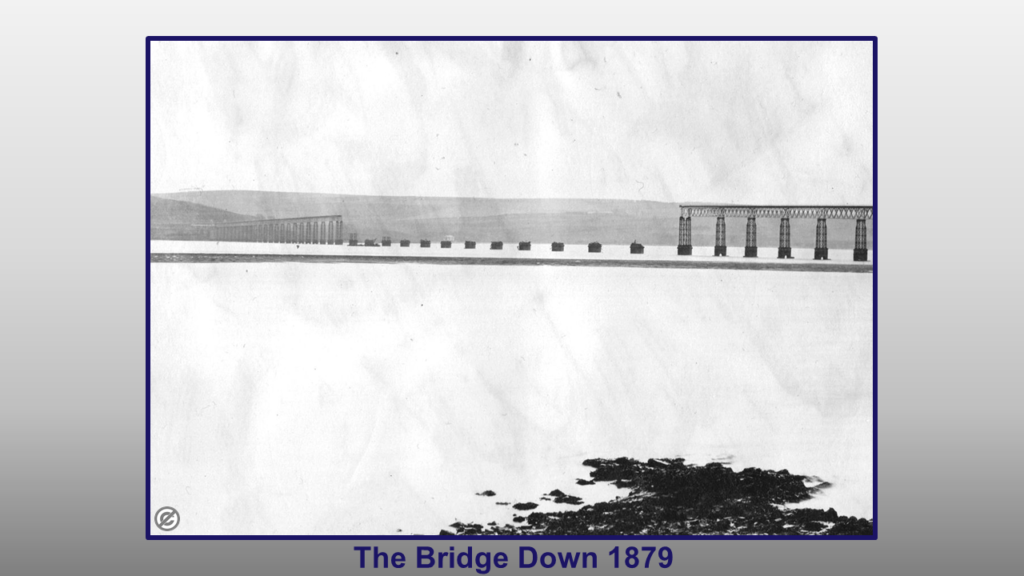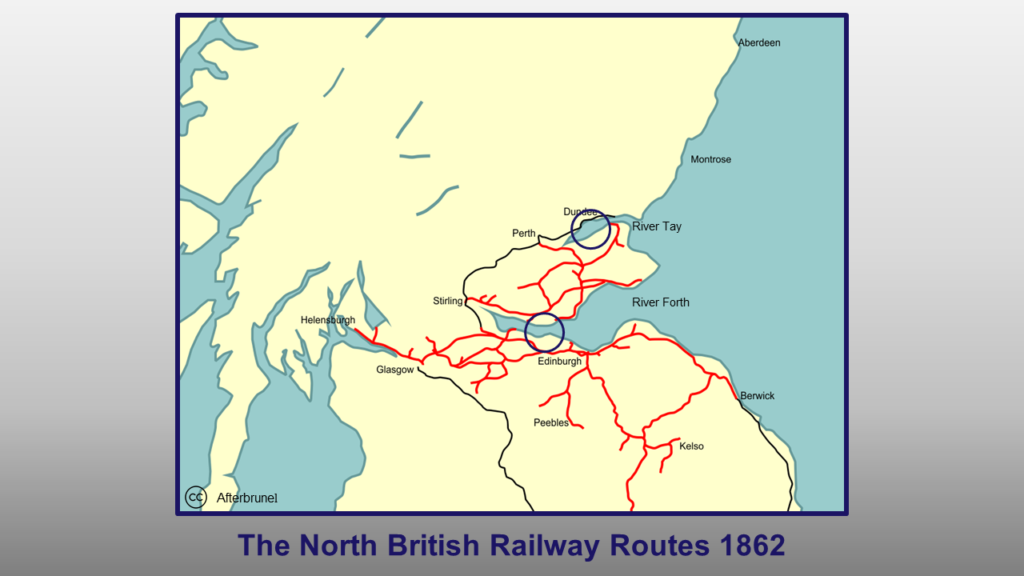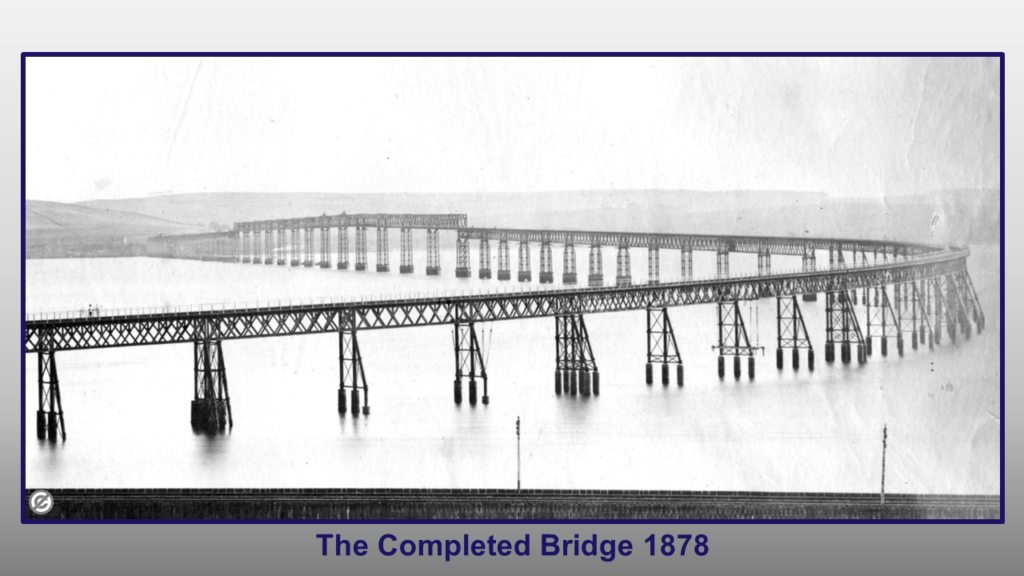Introduction
Around 7:00 in the evening John Watt struggles through the worst storm he can remember to visit his friend Thomas Barclay, the signalman at the Tay Bridge South Box.
Relieved to be out of the weather, John warms himself by the stove whilst looking out at the storm.
At 7:08 the signal bell rings to indicate that the Edinburgh train has just left St Fort.
Thomas signals the North Box and receives an acknowledgment.
The train comes into view slowing down.
Thomas goes out on to the boarding, walking alongside the train, as the fireman reaches out to take the bridge baton, as the train moves past, he notices faces in the carriage windows.
It was 7:13 when he returned to the signal box and signaled the north box that the train was on the bridge, receiving an immediate acknowledgement. He then sends all clear to Wormit.
John who has been watching the bridge, says There is something wrong with the train. Thomas is not worried and says You will see it again soon.
Again, John says The train has gone over.
Thomas says Wait we’ll see her soon
Still nothing so Thomas signaled the North Box, despite repeated attempts there is no reply.
Now worried they go out and attempt to enter the bridge but the wind is too strong, and instead they walk along the coast, until the clouds clear and they see that all the high girders are down and the train with them.
It was 7:20 on Sunday the 28th of December 1879.1

As a boy growing up in Dundee, I heard stories of the infamous collapse of the first Tay bridge. Stories of imperfect castings filled with compound to hide the flaws, of incompetence and poor design.
It was no longer part of living memory, but the effect of the tragedy was clearly still felt by my grandparent’s generation whose parents had lived through it.
How could this happen to the longest bridge in the world and a symbol of Victorian engineering greatness?
The Railway Man
Thomas Bouch was a man of the railway age, born near Carlisle in NW England on the 25th of February 1822.
Three years later saw the birth of steam powered railways with the opening of the Stockton to Darlington line, on 27th of September 1825.
After showing an early interest in engineering Bouch took a job with an engineering company, but after a short time he moved to what would be his lifelong vocation, railway engineering. He even spent time as the engineer for the famous Stockton and Darlington railway.
He joined the Edinburgh and Northern Railway as engineer in January 1849 and was introduced to his dream of bridging the two major estuaries blocking the route of the east coast rail line.

Meanwhile, Bouch put his energy into developing and implementing the first roll-on, roll-off ferries, on both the Forth and Tay crossings. This had huge savings in labour, removing the need to load and unload freight for the ferry crossings.
In 1854 he proposed to the board of the Edinburgh and Northern Railway, a bridge over the river Tay but it was rejected as a pipedream.
He then left the company and set-up as an independent railway engineer.
Over the next two decades he designed and built numerous railways and bridges, in his native northern England and Scotland, establishing a reputation for delivering cheap and functional railways.
But the dream persisted.
The Dream
The idea of bridging the Tay was again mooted in 1863, when a local solicitor1 held a public meeting where Bouch presented the case. A committee was formed, and a prospectus issued. It even progressed as far as a Parliamentary Bill3 which failed due to opposition from numerous quarters.
The idea surfaced again in 1866 after much “horse trading” had overcome most of the opposition but failed this time due to a financial crisis within The North British Railway Company. This resulted in the resignation of the Chairman Richard Hodgson a main driver of the project.
Fortunately, Hodgson’s replacement John Stirling was an advocate for the bridge, and recognized the strong business case.
In 1869 he and Bouch met with Dundee City Council and business leaders to present the case, and this time there was strong support. Subscriptions were taken and a bill presented in Parliament.
On the 15th of July 1870, the bill passed.
Bouch could now turn his dream into reality.
The Planning
Some planning was already underway prior to passing of the bill, but now everything could move forward.
Bouch had also been working on plans for a suspension bridge for the river Forth and had sought wind data and was advised that this would not be an issue, so there was no serious consideration of wind loading in the design.
He also commissioned a company to conduct survey boring and the report indicated solid rock about 20 feet down across most of the proposed site.
The design was almost two miles long with 89 lattice design spans of varying lengths, similar to that of the Belah viaduct. All this to be supported by brick columns except for those at the Dundee end (north) which would be cast iron.
One other factor, which attracted considerable criticism, was the fact that the bridge would be single track giving it a flimsy appearance.
This like many other factors which will become evident later were done for cost saving reasons.
The Search for a Contractor
Because of the size and complexity of the project there were only seven bidders for the contract, of which only three who met the budget estimate.
The selected contractor was Butler and Pitts, but they withdrew on the death of Mr Pitts.
The second choice was Charles de Bergue and Co., who commenced work in early 1871. However, things did not run smoothly and two years into the project Charles de Bergue died, and his wife was forced to relinquish the contact.
There then followed a period of months when work was stalled until a third contractor Hopkins Gilkes and Co. was assigned. Continuity was maintained by the retention of the site manager Albert Grothe.4
The Construction
Construction and accommodation facilities were built on the south shore at Wormit, along with a jetty to support the construction work.
Construction commenced January 1873.
The first order of business was to install the piers upon which the bridge columns would stand.
Prefabricated cylinders or “caissons” were floated out to their predetermined positions and then sunk vertically to the riverbed. The upper part of the caisson was sealed, with an airlock to allow access, and the water pumped out. A positive pressure was maintained within the caisson to prevent the river water reentering.
The workmen entered through the airlock and descended to the base where they dug away the material of the riverbed, allowing the caisson to sink deeper into the mud until it rested on bedrock. Once this was accomplished and the caisson was level, it would be lined with brickwork and then filled with concrete.
Caisson work was extremely hazardous for several reasons:
- The caisson could suddenly sink, pinning the workers under the mud5
- The outside water could rush in and drown the workers6
- To prevent water entering the caisson a positive pressure was maintained at all times, and like modern divers the workmen could suffer the bends when they returned to the surface7
Work progressed from the south shore until pier 15, when it was discovered that the boring reports were inaccurate and what was reported as bedrock was in fact compacted gravel layer.
This layer was insufficient to support the foundations and it was found that despite increasing the size of the piers they would sink under load.
The original specification called for a load of 6.5 tons /sq. ft. which had to be reduces to 2.75 tons/sq. ft. to achieve stability.
This meant that the piers could no longer support the brick columns.
Bouch fell back on a design he had used before, on the Belah viaduct, with cast iron tubes braced with iron bars. Originally each column would comprise eight cast iron tubes but due to space limitations on the pier the final design only included six.8
It is interesting to note that there were some design differences from the Belah viaduct, and the columns looked much less sturdy.
The redesign meant that there was a requirement for vast quantities of castings to make the columns. It was decided to make them on site at a foundry specifically built in Wormit for the purpose. There were a number of poor practices involved and claims of defects in the castings being concealed. However, we will look at that in more detail when we cover the Board of Trade inquiry, in the next post.
During the remainder of the construction things moved along relatively well except for one incident where high winds blew two of the lattice girders into the river during installation operations. One was scrapped and the other returned to the factory for repair and later use.
The Inspection
The bridge was completed, and test loaded with several locomotives in September 1877.
The Board of Trade inspector Maj. General Hutchinson visited the bridge for three days in February 1878, and after testing and inspecting it passed it for passenger traffic. He did note that he would like to observe the bridge in high wind conditions, but that was never done.

The Opening and Operation
The bridge was opened with much fanfare on the 31st of May 1878, and regular services commenced on the 1st of June.
It was a successful first year for John Stirling and the North British Railway Company.
With the new bridge they now carried 84% of the Edinburgh/Dundee passenger traffic, freight was up 40%, and the company stock had risen by 30%.9
Everything was looking rosy, but the best was yet to come.
Queen Victoria travelled south across the bridge on the 20th of June 1879, and seven days later she “knighted” Bouch at Winsor Castle.
The new Sir Thomas was now planning the next stage of the dream, bridging the river Forth.
The Dark Clouds
During this period there were some ominous warning signs and indicators that all was not well with the bridge, but they were ignored or minimized as all concerned basked in the glory of the longest bridge in the world and a rising stock price.
Since much of this only came to light during the Board of Trade inquiry, we will examine the details in the next post.
The Tragedy
In the confusion after the collapse it was initially thought there were as many as 300 dead. The number finally settled to 75 which was arrived at by counting tickets. However, the Tay Bridge Disaster Memorial Trust, arrived at the number of 59, based not on tickets, but on reports by the Railway company and relatives of the victims, and those are the 59 names that appear on the 2013 memorial.

The search for bodies and salvage operations continued for some time but this did not prevent other actions being taken:
- The Board of Trade Inquiry held its first meeting on the 3rd of January 1880
- A relief fund was immediately established to help the relatives of the victims
- The North British Railway Co. started planning the repair or replacement of the bridge
Conclusion
The dream had turned into a nightmare, innocent lives were lost, and families devastated, how could such an undertaking have ended so badly?
The reasons will be explored in the next post which will review the Board of Trade inquiry findings as well as modern engineering studies which shed new light on the subject.
Unfortunately, you will have to wait two weeks for that as I am taking a break for the Labour Day holiday – but it will be worth the wait.
NOTES
1John Prebble opens his book the High Girders with this account of the disaster, from the perspective of two North British Railway Company workers in the signal box at the south end of the bridge.
2Solicitor is the name usually given to lawyers in Scotland.
3At this time any new railway line or major railway infrastructure required its own Parliamentary Bill.
4The Fall of the Tay Bridge: p34-36
5Ibid p43
6Ibid p44 Details an account of an explosive decompression which drowned 6 men when the water rushed in
7The bends, or “caisson disease” as it was known at the time, was not well understood, and there were no decompression procedures. The workers simply exited the airlock at the end of the shift. When repeated over many weeks it could result in crippling disability
8Ibid p46
9Ibid p62/63
BIBLIOGRAPHY
- The Fall of the Tay Bridge: David Swinfen (2016)
- The High Girders: John Prebble (1975)

Another interesting historical blog!
Looking forward to Part 2 and the PM lesson learned.